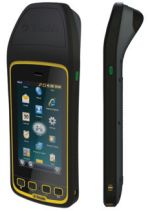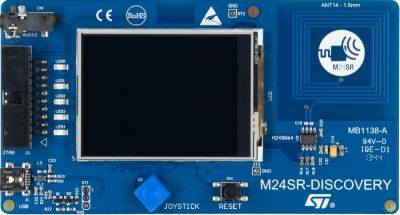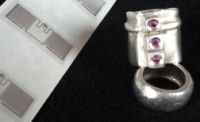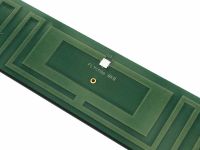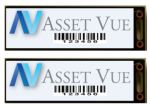Feb 13, 2014The following are news announcements made during the past week by the following organizations: Trimble; STMicroelectronics; Lab ID; MAINtag; Ekahau; Radius Networks; Asset Vue, No Limits Software.
Trimble Announces Juno T41 Rugged Handheld Computer with UHF RFID
Trimble has announced the Juno T41R rugged handheld computer with integrated ultrahigh-frequency RFID capabilities that is designed to automatically recognize tags across the UHF RFID frequency band (860 to 960 MHz). The new handheld series supports the EPC Global Gen 2 and ISO 18000-6C protocols and features an integrated ThingMagic M6e-Micro module. The series also features an integrated, orientation insensitive antenna (865-868 MHz or 902-928 MHz) that Trimble says provides rapid-read, high-accuracy performance on multiple tags with multiple orientations, even in crowded conditions. The integrated antenna has the ability to transmit up to +30 dBm (1 Watt) power, and the Juno T41R offers a read-range more than 3.5 meters with a 5-centimeter-wide (2-inch) UHF tag in unobstructed space, according to Trimble. The RFID capability can be combined with Enhanced GPS and/or smartphone connectivity so customers can choose a specific handheld model that meets their needs, the company said. The Juno T41R comes with preloaded with the Trimble SearchLight RFID tag reading application for configuration use-case parameters support. Trimble also offers a software development kit that can be used to customize all the settings including read range, power consumption and other features. The Juno T41R feature a 1 GHz processor and 512 MB RAM and 32 GB onboard storage with either the Android 4.1 or the Microsoft WEHH 6.5 operating system. Other standard features include an 8 megapixel integrated camera, multi-touch capacitive 4.3-inch sunlight-readable display and all-day battery life.
STMicroelectronics Unveils NFC Development Kit
STMicroelectronics has announced a new development platform for its M24SR Near Field Communication (NFC) RFID chips, which the company says are now entering volume production in all memory densities and package options. Unveiled in November 2013 (see RFID News Roundup: STMicroelectronics Unveils Family of ICs for Embedding NFC Tags in Electronic Devices), the embeddable M24SR family of NFC RFID chips contain three key elements: non-volatile memory (NVM) that retains its stored data even when its power supply is switched off; a wireless RFID interface for communicating with other wireless devices; and a wired interface (industry-standard I2C) for communicating with the host equipment's controller. The M24SR Discovery Kit, according to ST, contains everything engineers need to start adding NFC connectivity to any kind of electrical device, from fitness watches and loudspeakers to washing machines and water meters. The kit illustrates NFC use cases such as "tap and pair," URL connection, send an SMS or an e-mail message, and business-card download, the company says. The kit integrates a Dynamic NFC/RFID tag (M24SR64-Y), an STM32F1 microcontroller, a 13.56 MHz antenna, an LCD color screen, a USB connector, a JTAG connector, and a joystick for menu selection. The Premium version adds a Bluetooth module with audio outputs and a headset to demonstrate convenient Bluetooth pairing of a smartphone and an audio device with the M24SR. In addition to the discovery kit, the M24SR development ecosystem also includes antenna reference designs, application notes, e2e community, eDesignSuite, reference MCU drivers and an NFC Android App.
Lab ID Intros UHF RFID Tags for Tracking Very Small Items
Italian RFID firm Lab ID has announced a new series of ultrahigh-frequency (UHF) RFID tags designed to offer error-less traceability and anti-counterfeiting capability of very small items such as rings, watches, jewelry and pharmaceuticals. The UH601 family of tags feature either NXP Semiconductors' Ucode 7 chip or EM Microelectronic's EM4124 or EM4126 chip. According to Lab ID, the UH601 measures 30 millimeters by 10 millimeters and is more sensitive with a longer read range compared to the previous family (the U600) of UHF tags. The tags support the EPC Gen 2 and ISO 18000-6C standards and are designed to work in environment with high density of tags, according to Lab ID. The U601 tags are available in wet inlay format and can also be delivered as labels, customized in terms of materials, with RFID encoding and printing, if needed.
MAINtag Launches FLYchip64 High-Memory Chip for Aerospace
MAINtag has introduced FLYchip64, an update to its FLYchip product portfolio first unveiled in May 2013 (see RFID News Roundup: MAINtag Introduces New RFID-enabled, ATA Spec 2000-compliant FLYchip). MAINtag's FLYchip is compliant with specifications from the Air Transport Association of America (ATA)—now known as Airlines for America—as outlined in the ATA's Spec 2000 standard (newest version 4.0), and is embedded in the FLYtag range of RFID tags for the parts-marking of life vests, seats, medical kits, oxygen generators, in-flight entertainment systems and other flyable parts with life-cycle or expiration dates requiring inspection and inventory checks. According to MAINtag, performance tests have shown that FLYchip64 offers read range of up to 7 meters (nearly four times greater, MAINtag claims, than other existing available high-memory chips), has 65,536 bits user memory and 496-bits EPC & 208-bits tag identifier (TID), and is capable of a minimum operating power (in reading) of -15dBm, which according to MAINtag is four times better sensitivity than existing available high-memory chips, making it easy to design performing low- profile metal compliant tags. The FLYchip 64 also supports the GS1 EPC Tag Data Standard (TDS) 1.7, as well as 32-bits access password and 32-bits kill password to permanently disable the tag and the BlockWrite, BlockErase and BlockPermalock function on 16 bits boundaries.
Indiana School District Implements Ekahau RFID Panic Buttons at Three Schools
The Bluffton-Harrison Metropolitan School District in Bluffton, Ind., has implemented Ekahau's RFID-over-Wi-Fi real-time location system (RTLS) at its three schools, according to Ekahau. The RTLS solution--designed to support school-safety and emergency-response procedures and practices--consists of Ekahau's Wi-Fi-based RFID tags, infrared (IR) beacons to make location data more granular and Ekahau's Vision software. A teacher wears an Ekahau safety badge with the RFID tag embedded in it and, in the event of a medical, disciplinary or other type of emergency, pulls down on the badge's safety switch in order to alert coworkers and police dispatchers of the situation. If an alert is issued, the software captures and interprets the emergency's location, as well as other information. Within seconds, the software transmits a message directly to the appropriate badges inside the facility, thereby informing other personnel of the emergency's nature and where it is occurring. This, Ekahau says, helps police minimize emergency-response times by avoiding the need for map lookups and phone calls. The Ekahau Vision software also allows school officials to send mass notifications to teachers' badges, displayed as text messages on each badge's light-emitting diode (LED) screen. In addition, the software automatically time-stamps and records all emergency events and resolutions for review by school boards and police departments. For the Bluffton-Harrison school district, a pilot project that included 180 Ekahau badge tags worn by teachers on lanyards was successfully completed prior to the district-wide implementation, according to Ekahau. A number of other schools across the United States are also using Ekahau's RTLS (see RFID News Roundup: More Schools Select Ekahau's Location-Aware Panic-Button Solution).
Radius Networks Announces USB-powered Bluetooth Beacon
Radius Networks, a provider of mobile proximity services, announced its RadBeacon USB, a beacon that uses Bluetooth Low Energy (BLE) to transmit a unique ID number to notify cell phones and other mobile devices when they come within 100 feet. This micro-location proximity awareness can be leveraged to deliver a wide range of new innovative solutions, such as precision indoor navigation, automatic ticketing, guided museum tours and location-relevant offers and promotions, according to Radius Networks. The RadBeacon comes in form of a USB dongle that can be powered by any available USB power source. It is ideal for integrating with self-service kiosks, digital displays, point-of-sale terminals, fuel dispensers, vending machines and a host of other customer facing systems, according to Radius Networks. It comes with the iOS RadBeacon app , which can be used to configure the RadBeacon USB. The RadBeacon app gives users full configuration control of the RadBeacon USB's iBeacon advertisement data configuration, transmit power and advertising rate, making RadBeacon USB highly adjustable to suit a wide variety of deployment scenarios, according to the company. The iOS app is the first of several configuration tools and mechanisms that Radius Networks will be releasing shortly, says David Helms, VP of business development at Radius Networks. Other options will include a RadBeacon configuration utility for other platforms including (in order of planned release) the Android, Macintosh and Windows; direct access to the RadBeacon BLE configuration service for any BLE-capable client system through a published API; and a USB driver library for configuration through the USB serial interface of the device. Radius Networks also offers free "Locate for iBeacon" apps--one version for Android devices, the other for Apple iOS devices. The apps enable users to discover iBeacons around them, display the advertising information of those iBeacons and measure their proximity and distance to those iBeacons. The iOS version has an additional feature that enables users to transmit iBeacon advertisements, essentially turning an iPhone or iPad itself into an iBeacon.
Asset Vue, No Limits Software Partner on RFID-enabled Data Center Asset-Management Solution
Asset Vue, a provider of passive RFID-enabled asset management and data center management solutions, has announced it has forged a strategic partnership with No Limits Software, a provider of data center management solutions, to provide data center customers with IT asset audits that the two companies say are fast and easy to use. The solutions combine the Asset Vue Inventory with No Limits Software's RaMP data center infrastructure management (DCIM) solution. Asset Vue Inventory is an RFID-enabled data center asset management (DCAM) solution that includes all the hardware and software required for an organization to monitor data center assets within its data center and throughout its facilities. It includes both fixed and handheld data capture that provide read ranges from inches to feet making it fast and accurate to locate data center assets. The company has such customers as media, entertainment and communications company Comcast Corp. (see Comcast Puts RFID in Data Centers to Track Assets). The Asset Vue Inventory solution lets Comcast to use ultrahigh-frequency EPC Gen 2 RFID tags and readers to conduct audits, manage location data regarding thousands of IT assets, and provide alerts to employees conducting inventories, thereby indicating when a server is not at its expected location. No Limits Software's RaMP is designed to help companies solve issues faced in data centers by provides much greater data accuracy, automatic discovery of detailed device configuration and real-time monitoring of both IT and facilities equipment. Its real-time monitoring capabilities monitor power from the utility all the way down to the IT device level (servers, blade servers, and virtual machines) as well cooling devices and environmental conditions and can receive SNMP traps from any device and automatically acknowledge cleared alarms.

